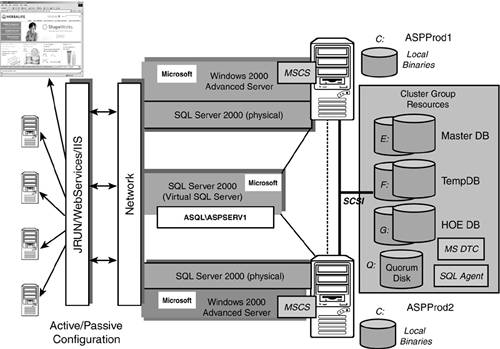Application Service Provider—Scenario #1 with SQL Clustering
As you may recall from Chapter 3, “Choosing High Availability,” the application service provider (ASP) business scenario (scenario #1) yielded a high availability selection of hardware redundancy, shared disk RAID arrays, MSCS, and SQL clustering. Having these four options together clearly met all of their requirements of uptime, tolerance, performance, and costs. The ASP's service level agreement with their customers also allows for brief amounts of downtime to deal with OS upgrades or fixes, hardware upgrades, and application upgrades. The ASP's budget was enough for a larger amount of hardware redundancy to be utilized.
The ASP planned and implemented three separate clusters in order to support their eight major customer applications that are using SQL Server 2000. Each SQL cluster was a two-node cluster configured in the active/passive mode. There customers wanted to make sure that if a failure of a node ever occurred, performance would not be effected. One way to guarantee this is to use the active/passive mode. In other words, since a failed node is not failing over to an active node, there would not be any current processing burden to compete with (that would exist in an active/active configuration). As illustrated in Figure 5.36, each two-node SQL cluster can support between one and three separate customer applications. The ASP established a guideline of never exceeding three applications per SQL cluster to help them mitigate risk overall (and, all of their customers agreed to this approach of minimizing risk). The primary customer application depicted in Figure 5.36 is an online (Internet) health products order entry and distribution system. The HOE database is the main order entry database with between 50 and 150 concurrent SQL Connections. When the ASP someday reaches their tenth major customer application, they will simply create a new 2-node cluster. This is proving to be a very scalable, high-performance, risk mitigating, and cost-effective architecture for them.
From an ROI point of view, ROI can be calculated by adding up the incremental costs (or estimates) of the new HA solution and comparing them against the complete cost of downtime for a period of time (one year in our example).
We had previously estimated the total incremental costs to be in the range of between $100K and $250K, which included
Five new four-way servers (with 4GB RAM, local SCSI disk system RAID 10, 2 ethernet NICs, additional SCSI controllers [for shared disk]) at $30K per server
Five MS Windows 2000 Advanced Server licenses ≈ $3K per server (Windows 2003 Enterprise Edition $4K per server)
Eighteen SCSI disk systems with RAID 10 (minimum of 6 drives per SCSI disk system, 4 shared SCSI disk systems per cluster—72 drives in total) ≈ $55K
Five–seven days of additional training costs for system admin personnel ≈ $15K
Two new SQL Server licenses (SQL Server 2000, Enterprise Edition) at $5K per server.
Total incremental costs to upgrade to this SQL clustering high availability solution are approximately $245,000 (approximately $81,666 per two-node cluster).
Now, let's work through the complete ROI calculation with these incremental costs along with the cost of downtime:
Maintenance cost (for a one year period):
$15K (estimate)— yearly system admin personnel cost (additional time for training of these personnel)
$25K (estimate)— recurring software licensing cost (of additional HA components; [5]OS + [2]SQL Server 2000)
Hardware Cost:
$205K hardware cost (of additional HW in the new HA solution)
Deployment/Assessment Cost:
$20K deployment cost (develop, test, QA, production implementation of the solution)
$10K HA Assessment cost
Downtime Cost (for a one year period):
If you kept track of last year's downtime record, use this number; otherwise produce an estimate of planned and unplanned downtime for this calculation. We estimated the cost of downtime/hour to be $15K/Hour for this ASP.
Planned downtime cost (revenue loss cost) = Planned downtime hours × cost of hourly downtime to the company:
.25% (estimate of planned downtime percentage in one year) × 8760 hours in a year = 21.9 hours of planned downtime
21.9 hours (planned downtime) × $15K/hr (hourly cost of downtime) = $328,500/year cost of planned downtime.
Unplanned downtime cost (revenue loss cost) = Unplanned downtime hours × cost of hourly downtime to the company:
.25% (estimate of unplanned downtime percentage in one year) × 8760 hours in a year = 21.9 hours of unplanned downtime
21.9 hours × $15K/hr (hourly cost of downtime) = $328,500/year cost of unplanned downtime.
ROI Totals:
Total costs to get on this HA solution = $285,000 (for the year—slightly higher than the stated immediate incremental costs)
Total of downtime cost = $656,000 (for the year)
The incremental cost is 43% of the downtime cost for one year. In other words, the investment of the HA solution will pay for itself in .43 of a year or approximately 5 months! We can see why this ASP didn't blink and eye to get into this HA solution as rapidly as they could.

